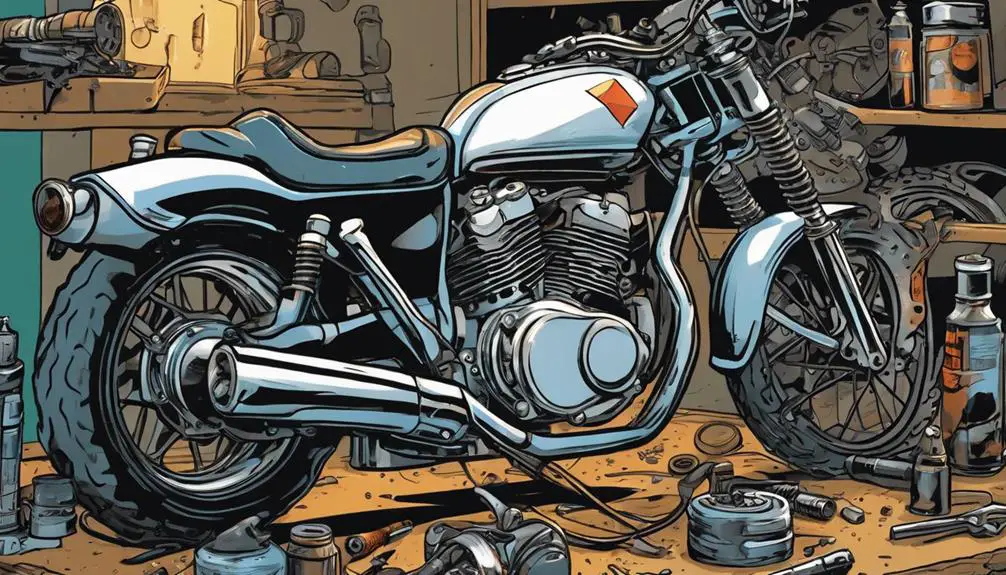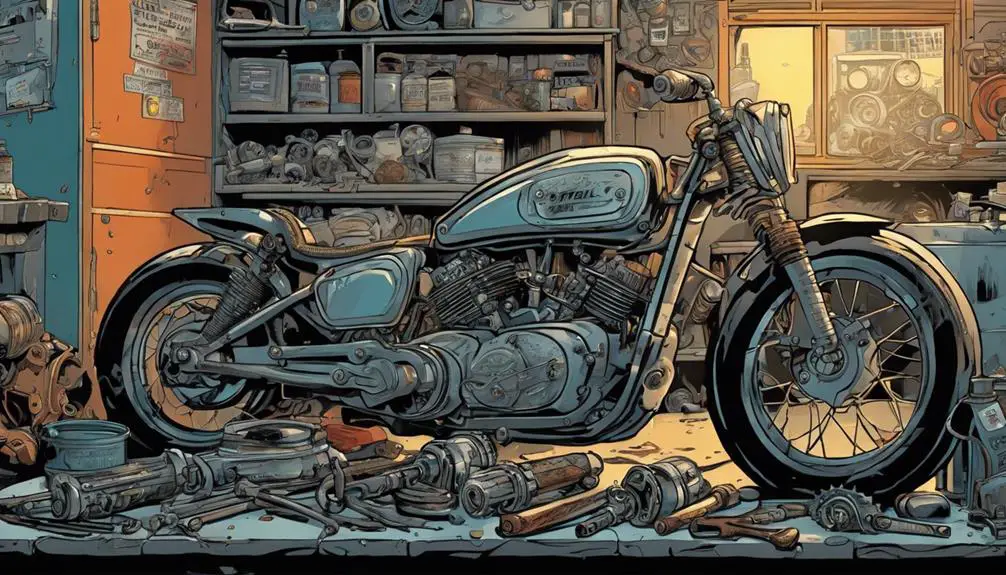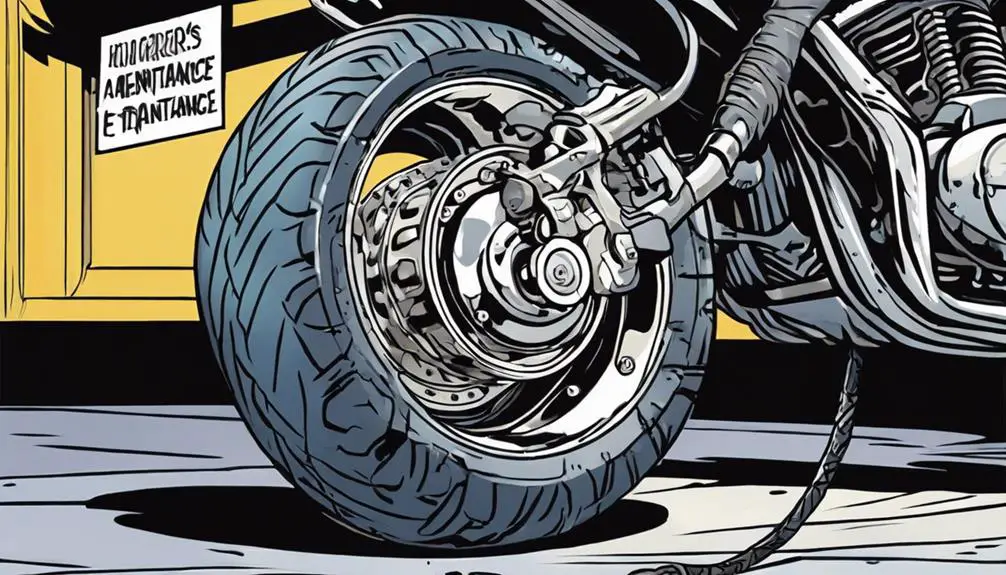Motorcycles can be like finely tuned orchestras, but even the best ones hit a sour note now and then. You might find yourself facing common issues, from engine problems to electrical glitches, which can disrupt your ride and safety. Understanding the root causes and effective solutions is essential for maintaining your bike's performance. What if you could spot these issues before they escalate? Let's explore the common problems you might encounter and the straightforward solutions that can help keep your motorcycle running smoothly.
Quick Takeaways
- Engine issues often stem from clogged fuel filters or faulty spark plugs; regular maintenance can prevent performance problems.
- Electrical failures commonly arise from dead batteries or frayed wiring; ensure connections are clean and terminals secure.
- Transmission troubles can be caused by low fluid levels or misaligned shift linkages; routine checks and adjustments are essential for smooth shifting.
- Brake system concerns include spongy brakes or worn pads; immediate attention is crucial to ensure rider safety.
Suzuki Engine Issues

Suzuki motorcycles often face engine issues that can affect performance and reliability. You might notice problems like rough idling, reduced power, or excessive vibrations. These symptoms can drain the joy out of your ride, stifling your spirit of freedom.
One common issue is a clogged fuel filter. If you find your bike struggling to accelerate, it might be time to check and replace that filter. A clean fuel system guarantees your engine gets the lifeblood it needs to roar down the open road.
Another culprit could be a faulty spark plug. If your engine misfires or stutters, swapping out the spark plug can restore your bike's energy.
Don't overlook regular maintenance, either; changing the oil and air filters keeps your engine humming smoothly.
Electrical System Failures
Electrical system failures can leave you stranded and frustrated, as issues like dead batteries or malfunctioning wiring disrupt your ride. If your bike won't start, the first thing to check is the battery. Make certain it's charged and the terminals are clean and secure. If you're still having trouble, it could be a faulty ignition switch or a blown fuse.
Wiring issues can be sneaky, often hiding beneath the surface. Look for frayed wires or loose connections that might disrupt the flow of electricity. A quick visual inspection can save you from a long wait on the side of the road.
Investing in a multimeter can help you diagnose electrical problems more effectively. With one, you can test voltage and continuity, empowering you to fix issues before they leave you helpless.
Don't ignore warning lights on your dashboard; they're your bike's way of communicating potential problems. Keeping your electrical system in check not only guarantees a smoother ride but also gives you the freedom to explore without fear. Embrace the road with confidence, knowing you've got electrical issues under control!
Transmission Troubles

When it comes to transmission troubles, you might notice issues like slipping gears or difficulty shifting that can ruin your ride. These problems can disrupt your freedom on the open road, leaving you frustrated and stranded.
To tackle this, first, check your clutch cable. A loose or worn cable can lead to shifting issues, so adjust or replace it as necessary.
Next, inspect your transmission fluid. Low or dirty fluid can cause poor performance. Verify you've got the right type and level of fluid; topping it off or changing it can make a huge difference.
If you're still experiencing problems, look at the shift linkage. Misalignment can lead to difficulties when you shift gears. Adjusting it might just restore that smooth ride you crave.
Lastly, if the issue persists, don't hesitate to consult a professional mechanic. They can diagnose underlying problems that may not be obvious to you.
Brake System Concerns
Brake system concerns can seriously impact your safety and ride quality, so it's crucial to address any issues promptly.
Whether you're cruising down the highway or winding through the countryside, reliable brakes are non-negotiable.
If your brakes feel spongy, it might indicate air in the brake lines. You can bleed them yourself or head to a mechanic for a thorough job.
Worn brake pads can also compromise your stopping power. Keep an eye out for squeaking or grinding noises, as these are signs that it's time for a replacement.
Don't forget to check your brake fluid levels; low fluid can lead to brake failure.
If you notice any leaks, tackle them immediately, as they can lead to bigger problems down the road.
Tire and Suspension Problems

When riding, you can't overlook the importance of your tires and suspension.
Keeping an eye on tire wear indicators and knowing how to adjust your suspension can enhance your safety and riding experience.
Let's explore some tips to help you maintain these critical components.
Tire Wear Indicators
Tire wear indicators are essential for monitoring your motorcycle's tire health and preventing suspension issues that can compromise safety and performance. These indicators, often built into the tire tread, signal when it's time to replace your tires, ensuring you stay in control during your rides.
When you check your tires, look for the small raised bars or indicators within the tread pattern. If the tread wears down to the same level as these indicators, it's time for a change. Ignoring this can lead to decreased grip, increasing the risk of skidding or losing control, especially in wet conditions.
You'll want to regularly inspect your tires for uneven wear patterns, cracks, or bulges as well. Such signs can indicate deeper issues with your suspension or alignment, potentially impacting your overall ride experience.
Suspension Adjustment Tips
Adjusting your motorcycle's suspension can greatly enhance your ride quality and handling, ensuring a smoother experience on the road. To begin, check your owner's manual for suspension settings specific to your bike. Understanding preload, compression, and rebound settings is essential.
Start with preload, which affects the bike's ride height and sag. Measure the sag by sitting on the bike and noting the distance the suspension compresses. Aim for about 25-30% of your total suspension travel for a balanced ride.
Next, adjust compression settings. This controls how quickly your suspension absorbs bumps. If you're hitting hard on rough roads, increase the compression to stiffen it up. Conversely, if you want a softer feel, decrease it.
Regular Maintenance Practices
Regular maintenance is key to keeping your motorcycle in top shape and preventing issues down the road.
You need to stay on top of routine checks, monitor fluid levels, and guarantee your tires are in good condition.
Importance of Routine Checks
Routine checks are essential for keeping your motorcycle in top shape and preventing costly repairs down the road. When you take the time to inspect your bike regularly, you're not just maintaining a machine; you're ensuring your freedom on the open road.
Start with a visual inspection. Look for any signs of wear, rust, or damage. Check your tires for proper inflation and tread depth; these are your lifelines to the asphalt. Don't forget the brakes; they need to be responsive and reliable.
Next, examine your lights and signals. They're crucial for safety and visibility. If something's amiss, fix it before hitting the highway.
Also, check the chain and cables. A little tension can go a long way in enhancing performance and extending the life of your ride.
Fluid Level Monitoring
Monitoring fluid levels is a key part of maintaining your motorcycle's performance and longevity. You want your ride to feel free and powerful, and keeping an eye on fluids is crucial for that.
Start with the engine oil—it lubricates critical parts and keeps them cool. Check it regularly and top it off as needed. Low oil can lead to serious engine damage, which can cramp your style.
Next, don't forget the coolant. It prevents your engine from overheating, especially during those long rides. Make sure it's at the proper level, and look out for leaks. If you spot any, act fast.
Brake fluid is another important fluid that guarantees your safety. Low levels can affect your braking performance, putting you at risk on the road. Regularly inspect it and replace it if it looks dirty or has absorbed moisture.
Lastly, check the chain and transmission fluids. Proper lubrication keeps your bike running smoothly, allowing you to enjoy every twist and turn.
Tire Maintenance Essentials
Keeping your tires properly inflated and well-maintained not only enhances your motorcycle's handling but also guarantees your safety on the road. To achieve this, incorporate these essential tire maintenance practices into your routine:
- Check tire pressure regularly, ideally before every ride.
- Inspect tread depth to guarantee adequate grip and performance.
- Look for signs of wear or damage, like cracks or bulges, which can jeopardize your safety.
- Rotate your tires as recommended to promote even wear and extend their lifespan.
Common Questions
How Can I Improve My Motorcycle's Fuel Efficiency?
To improve your motorcycle's fuel efficiency, start by checking your tire pressure regularly; under-inflated tires can drag you down.
You should also clean or replace the air filter to guarantee peak airflow.
Regular maintenance, like oil changes, keeps your engine running smoothly.
Ride at steady speeds and avoid rapid acceleration, as those habits can drain your fuel faster.
What Are the Signs of a Worn-Out Chain?
When your motorcycle's chain starts to feel like a limp noodle, it's time to pay attention. Signs of a worn-out chain include excessive slack, rust, or visible wear on the links.
You might also hear strange noises while riding, a telltale sign that something's amiss. Don't ignore these symptoms; a healthy chain means smoother rides and less hassle.
Keep your freedom alive by maintaining your bike, so you can chase the open road!
How Do I Choose the Right Motorcycle Oil?
Choosing the right motorcycle oil isn't just about brand; it's about understanding your bike's needs.
You'll want to check your owner's manual for the recommended viscosity and type, like synthetic or mineral oil.
Consider your riding style—if you're hitting the open road or facing harsh conditions, that'll influence your choice.
When Should I Replace My Motorcycle Battery?
Picture the thrill of the open road, the wind whipping past as your bike purrs beneath you.
But if your motorcycle struggles to start or the lights flicker, it's time to evaluate your battery.
Generally, you should replace it every three to five years, especially if it shows signs of wear.
Trust your instincts; a reliable battery fuels your freedom, ensuring every ride feels as exhilarating as the first.
Can Weather Affect Motorcycle Performance?
Absolutely, weather can impact your motorcycle's performance.
When it's cold, your bike may struggle to start and the engine mightn't run as smoothly.
Hot weather can lead to overheating, affecting power and handling.
Rain and humidity can reduce traction and increase the risk of rust.
Wrapping Up
To sum up, addressing common motorcycle problems promptly can save you from bigger headaches down the road.
By staying on top of regular maintenance and being vigilant about symptoms, you can keep your ride smooth and safe.
After all, wouldn't you rather enjoy the open road without worrying about unexpected breakdowns?
Embrace good habits, and your motorcycle will reward you with reliability and performance for many miles to come.